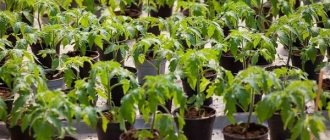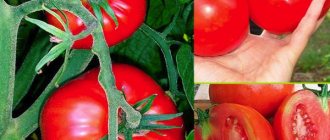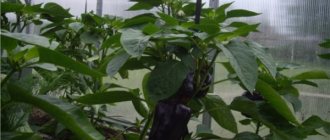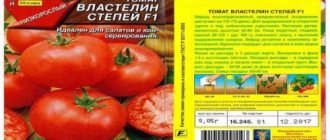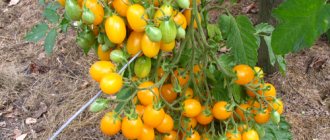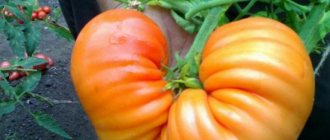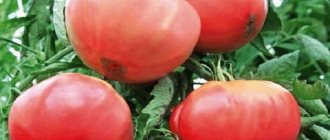Reading reviews about the Olesya tomato, you may decide that this is the ideal variety. People rave about its taste, hardiness, large fruit size and versatility. Thanks to its excellent taste, the tomato is gaining increasing popularity.
| Height | Landing location | Ripening time | Fruit color | Fruit size | Origin | Fruit shape |
| Tall | Greenhouse, Open ground | Mid-early | Orange | Large | Variety | Plum-shaped or oval |
Description and characteristics of the variety
Olesya tomato bushes are indeterminate, tall, about 1.6-1.8 m. The leaves are large, the plant branches moderately. The variety is mid-early, sometimes called mid-ripening - the period of fruit ripening is from 95 to 110 days from the moment of germination. The tomatoes are oval or plum-shaped, quite large - on average 150-300 g, but some gardeners received specimens up to 370 g. The color is deep orange, the skin is smooth and thin. There are some seeds inside.
Tomato Olesya “Siberian Garden” has dense and fleshy pulp and a pronounced tomato aroma. Used for salads, in cooking, for processing into juices and sauces. You can preserve the whole thing, but the skin may crack.
The pulp of orange tomatoes does not overload the digestive system and is suitable for light dietary dishes.
Rules for planting and care
When caring for Olesya tomatoes, standard agricultural techniques are used.
Growing seedlings
Orange variety tomatoes are sown at a time characteristic of the region, approximately 60-65 days before planting in a greenhouse or open ground. For the first sowing, select a bowl up to 6-8 cm deep, and for picking, separate cups for each tomato with a diameter of 8-10 cm and a depth of up to 10 cm. Purchase a special substrate for seedlings if there is no soil prepared in the fall. For tomatoes, they independently collect the following composition:
- 1 part each of turf or garden soil, humus, peat or sand;
- add a quarter cup of wood ash, 1 teaspoon each of superphosphate and potassium sulfate to 10 liters of mixture.
The seeds are soaked for 15 minutes in potassium permanganate and then in some kind of growth stimulant. Some gardeners from Siberia claim that plants made from untreated seeds are more resistant to cold weather. The seeds are immersed 1 cm into the substrate, the container is covered with film and placed in a place with a temperature of 23-25 °C. After 6-7 days, the seedlings are subject to the first hardening, reducing the heat to 17-18 °C. The strengthened sprouts are transferred to a bright windowsill or under a phytolamp and moistened regularly. When the first true leaves are already growing, the tomatoes are transplanted into separate containers, pinching the central root by 1-1.5 cm. The seedlings develop well at a temperature of 23-25 °C.
Transplanting seedlings
After 55-60 days, Olesya tomato seedlings, according to the description of the variety and its characteristics, lay the first flower cluster. By this time, the containers should be taken out into fresh air for 10-14 days for hardening. Tomatoes have been planted in a greenhouse without heating since the beginning of May. It is customary to move seedlings of the variety to an open area:
- in the southern regions - from mid-April;
- in the central climate zone of Russia from May 10 to June 7;
- in the Urals and Siberia - from the middle of the last ten days of May to the second ten days of June.
Comment! For 1 sq. m place 3 Olesya tomato bushes, if they lead to 2 stems, and 4, leaving only 1 stem.
Aftercare
In open ground, water after 2-3 days if there is no rain. Water is heated in the sun, 1.5-2 liters are poured under each root. In the greenhouse, water every other day, in the furrows between the rows, avoid the sprinkling method, because due to excess dampness, whitefly infection is possible. It is important to ventilate the room so that the humidity is between 65-75%. After watering, the dried soil is loosened in the first weeks to 10 cm, then superficially - up to 5-6 cm, so as not to damage the roots, and mulched. 9-12 days after planting, the bushes of tall Olesya tomatoes, according to the description and photo, are earthed up after mandatory watering to strengthen the root system, then the procedure is repeated 2 weeks later.
The variety is fed after 16-21 days. Dilute in 10 liters of water:
- 1 tbsp. l. ammonium nitrate;
- 2 tbsp. l. potassium chloride;
- 3 tbsp. l. superphosphate.
This composition is used before mass ovary. Then the fertilizer ratio is changed:
- 2 tbsp. l. superphosphate and ammonium nitrate;
- 3 tbsp. l. potassium chloride.
1 liter of fertilizer is poured under the root. It is more convenient to use complex mineral preparations.
How to get high-quality Olesya tomatoes
Among the variety of tomato varieties, it is difficult to choose the most worthy one - one that would not require special care and would be distinguished by high taste. Before planting a crop, it is necessary to study the characteristics of the variety and compare different options. Let's consider the characteristics and description of the Olesya variety and the technology of its cultivation.
Description and characteristics of the variety
The Olesya tomato is grown both in open ground and in greenhouse conditions.
The plant is indeterminate, that is, the bushes are not limited in growth, reaching a height of 2-2.5 m. Therefore, tomatoes must be tied up. The foliage is dark green and large. The fruits have a plum-shaped elongated shape. Color yellow-orange. The surface of the tomato is smooth and glossy. The pulp is of medium density, juicy, very few seeds. The weight of one tomato varies from 150 to 300 g.
Diseases and pests
First of all, it is important to remove all weeds on the site before planting seedlings and during the growth and fruiting of Olesya tomatoes, so the likelihood of pests appearing in the garden is sharply reduced. This species is little susceptible to various diseases inherent in nightshade crops.
Under unfavorable conditions, the Olesya tomato variety may suffer from the following diseases:
- late blight;
- gray rot;
- mosaic.
Fungicides or spraying with manganese solution are used against fungal infections. Parts of the plant affected by the fungus should be removed.
Olesya tomatoes can be attacked by the Colorado potato beetle, spider mite, and May beetle larvae. To prevent the appearance of pests and their larvae on the site, you should regularly loosen the soil and get rid of harmful insects. Planting radishes and mustard between rows helps prevent pest invasion. If the pest invasion is widespread, the tomato bushes are sprayed with chemicals.
Caring for tomatoes Olesya
The Olesya tomato variety is in many ways similar to other tomatoes, and therefore needs similar care. This vegetable responds positively to good watering and regular fertilization.
The main methods of tomato care are hilling, weeding beds, watering, forming bushes, using fertilizers, as well as timely control of diseases and pests.
Watering and fertilizing
Watering should be done daily, water consumption is distributed according to circumstances. During heavy rainy weather, water rarely or not at all. Because excess moisture is harmful and promotes the formation of rot. After watering, the holes must be loosened and at the same time get rid of weeds.
Fertilizers are applied several times over the entire period of vegetable growth. First, after a week from the moment of planting the seedlings, then during the period of flowering of the bush and formation of fruits. For this purpose, various mineral and organic fertilizers are used.
As the plant grows, it is chopped and tied to cuttings to create better support. The fight against diseases and pests consists of proper care and timely application of fertilizers.
Pinching and tying
After transplanting Olesya tomatoes into open ground or a greenhouse, they are tied in two places - at the base and near the top. This is necessary for all indeterminate varieties with unlimited growth to strengthen the stem and maintain its integrity during the process of fruit ripening.
Pinching is carried out after planting Olesya tomatoes in open ground after 2-3 weeks. By this time the plant should begin to grow. In the process, all lateral shoots longer than 5 cm in the leaf axils are removed, leaving one strong stem. This will reduce the growth of the green mass of the bush and increase the weight of future fruits.
Loosening
After watering, it is necessary to loosen the soil around the holes with tomatoes each time, while weeding the weeds. The first time you need to loosen the soil to a depth of 9-12 cm. Then the loosening depth can be reduced to 4 centimeters. Compaction of the soil should not be allowed, as this will adversely affect the growth and development of tomatoes.
Advantages and Disadvantages of Culture
Tomato yields lag behind the most productive varieties. Along with this disadvantage, there are other disadvantages:
- Limited culinary use. Tomato is best eaten fresh. When preparing sauces, purees or juices, take into account the non-standard taste of orange fruits. In the jar as a whole, tomatoes sometimes crack.
- Thermophilia. It is appropriate to grow in a garden bed only in warm latitudes.
- Need for proper care: shaping, pinching, gartering.
Tomatoes also have many advantages:
- good sweet taste, high carotene content;
- medium sized fruits;
- adaptability of the harvested crop to long-term storage;
- good safety indicators during transportation;
- immunity to yellow leaf dwarf.
Find out more about tomato diseases here.
Reviews from gardeners
Olga from Brest region. (Belarus) notes the thinness and instability of the tomato. She formed the only greenhouse bush into 1 trunk 1.7 m high. 4 brushes grew on it, about 5 leaves later. Otherwise, the tomato confirmed its characteristics from the originator's annotation. Including mediocre productivity.
Larisa from Lipetsk confirms these theses. In the photo, the fruit from her harvest has an uneven orange color. There is a small green spot on the side of the stalk. The weight of the tomato is 131 g. The summer resident liked the taste - juicy and sweet. However, the place of cultivation is not indicated.
Love from Tomsk region. I grew the variety both in the greenhouse and in the garden. In the second case, the fruits set were smaller, but in larger quantities. In her review, she noted the keeping quality of the tomato. Evgeniy from Nizhny Novgorod talks about tomatoes weighing up to 370 g. 9 large beauties grew on the lower ovary. The gardener also praised the taste of the variety.
Breeders honestly stated the low productivity of the Olesya tomato. But this drawback is offset by the decent commercial qualities and taste of tomatoes.
Growing seedlings
You should only buy seeds for seedlings from trusted sellers or suppliers. This will help avoid getting rotten or diseased food. Experts recommend purchasing seeds from specialized garden stores. On the back of the package you can read a short description of the variety.
Planting seeds
After purchasing seeds, they can be treated with a manganese solution. This will help disinfect the plant and remove any possible bacteria in it.
Seeds need to be planted 65 days before the sprouts are transplanted into the ground. Olesya tomatoes need to be planted at a distance of 30-40 cm to protect the root system and growth of the plant.
Sprout care
Small stems with leaves, up to 10 cm high, will begin to appear in the soil. You need to grow sprouts taking into account the room temperature, lightening and humidity. The depth of seed placement cannot exceed 1 cm. Future tomatoes are covered with film or special caps.
The temperature should be between 23 and 25 degrees. This helps the seeds germinate or the sprouts continue to grow.
Optimal lighting will be created by the lamp. In the first 5 days it should work around the clock. Later, daylight hours for sprouts are 12-17 hours.
You cannot water the plant before the sprout appears. This can lead to waterlogging of the soil and plant.
Diseases and prevention
Despite the resistance of Olesya tomatoes to diseases and pests, prevention will not be superfluous. Among the diseases that can negatively affect tomatoes are the following:
- mosaic;
- late blight;
- blossom end rot of tomatoes;
- gray rot.
Gardeners have already developed some measures to combat such diseases. Manganese solutions are excellent against mosaic and late blight. You can try removing infected leaves or bushes.
You can get rid of different types of rot using a solution of calcium nitrate. The recipe is quite simple: for 10 liters of water you need 1 tablespoon of the product. Many farms choose the Olesya tomato from year to year, and reviews say that this choice is 100% justified.

